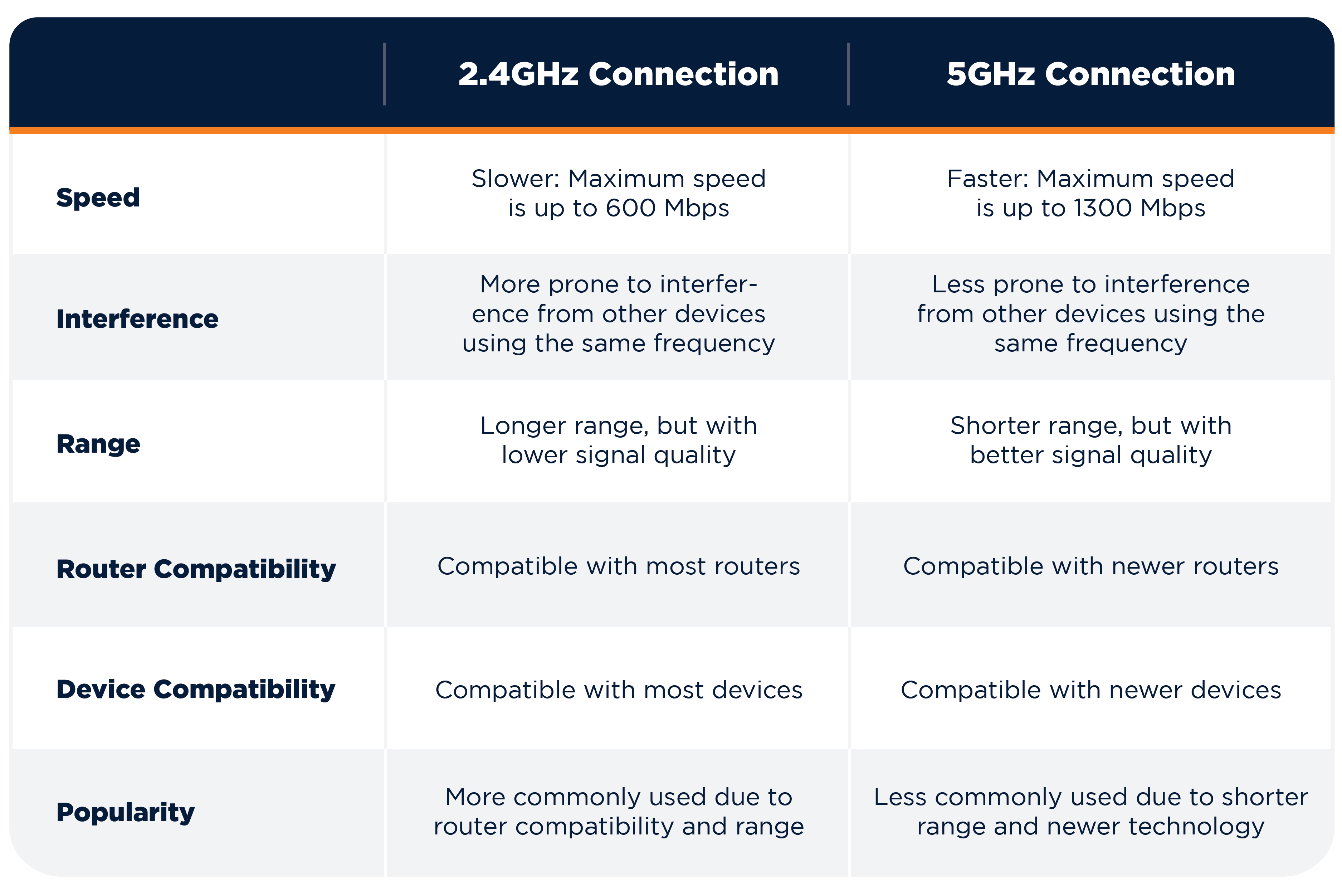The differences between 2.4GHz vs 5GHz connection may appear subtle, but they have bold implications. To ensure you select the best frequency for your needs, you’ll want to consider a variety of factors including but not limited to the layout of your home, placement of your router, and the ways you use your Wi-Fi. With these factors in mind and a basic understanding of Wi-Fi technology, you’ll be equipped to make an informed and quality decision.
Key Takeaways:
- 2.4 GHz is best suited for low bandwidth activities such as web browsing while 5Ghz is ideal for high bandwidth applications like gaming or streaming video content
- The 2.4 GHz has a longer range but can suffer from more interference while 5Ghz signals are less susceptible to interference from other devices
- Your choice of frequency band should depend on your environment and specific wireless network needs

There are few reasons one might be researching 2.4GHz vs 5GHz. Of them, the most common is a desire to get the best performance from their Wi-Fi. While your frequency band will play a part in your Wi-Fi experience, there are other factors to consider such as data transfer rates, network congestion, distance from the internet source, and quality of equipment used.
A discussion of all of those factors would fill a much longer article and is not on our agenda today. We will, however, discuss the difference between 2.4GHz and 5GHz as they pertain to your wireless internet connection and address when one might be better than the other.
But before we do, let’s gain some common ground by answering a few technical questions.
What is GHz?
Put simply, GHz is a measurement of the radio frequencies that transmit your Wi-Fi signal from your router to your device.
More technically, GHz, or Gigahertz, is the unit for measuring frequency. It is equal to one billion hertz (1 GHz = 1,000,000,000 Hz). A hertz is one cycle of a frequency, or one up and down in the frequency’s wave. GHz is used to measure how fast a Wi-Fi signal, or wave, can travel from your router to your device and back again. The higher the number of GHz the faster and stronger your connection will be.
It is important to note that the GHz frequency is not the only determining factor in the speed of your internet connection. Other factors, such as the quality of your router, the number of devices connected to the network, and the bandwidth provided by your internet service provider, also play a critical role in the overall speed and performance of your Wi-Fi network
Does GHz Measure the Speed of Your Internet?
Not exactly. GHz measures the performance of your wireless internet connection based on the variety of factors mentioned earlier. Wi-Fi speed is measured in Mbps or Gbps, which refer to data transfer rates. While GHz plays a role in Wi-Fi technology, it is not used to measure the speed of the wifi network. Depending on your frequency band, proximity to your router, and the amount of people using your Wi-Fi, your frequency can provide an all around better Wi-Fi experience.
What is a Frequency Band?
A frequency band is the range of a radio wave frequency that transmits data. When it comes to Wi-Fi, higher frequencies mean data is transferred more quickly but across a smaller distance. There are two main Wi-Fi frequency bands: the 2.4GHz band and the 5GHz band. Depending on how you use your Wi-Fi, both frequencies present their own strengths and weaknesses.
Let’s have a closer look.
The Differences Between 2.4GHz vs 5GHz Connection

2.4GHz and 5GHz are the two most commonly used frequency bands in wireless networks. While both bands can connect devices wirelessly, there are some key differences between them.
The 2.4GHz band has become a universal frequency band due to its longer range and compatibility with most electronic devices. However, its popularity has led to compromised bandwidth resulting in more interference, ultimately degrading network performance. The presence of cordless phones, baby monitors, and other wireless devices that operate on the same frequency band exacerbates the problem.
On the other hand, the 5GHz band, although relatively new, offers a faster and more stable network experience due to its wider channel availability, which results in faster data transfer rates. The weakness here is that the shorter wavelength of the 5GHz frequency leads to a shorter range, and it is more susceptible to signal loss due to physical obstacles.
The physical properties of radio waves make are what make up the key differences between the two frequencies. 2.4GHz frequency is more penetrative than the 5GHz frequency, which results in a longer range. The longer wavelength of 2.4GHz can easily penetrate walls and other solid objects, which is ideal for large spaces with multiple barriers. The shorter wavelength of the 5GHz frequency, on the other hand, makes it less penetrative and often requires line-of-sight to deliver its intended performance.
Which WiFi Frequency Band is Best?
The trade-off between range and speed makes both frequency bands suitable for different applications. For example, in environments with large spaces or long-distance transmissions, the 2.4GHz band is more suitable. In contrast, the 5GHz band is ideal for short-range transmissions in smaller indoor spaces with fewer physical obstructions.
The 2.4GHz band is ideal for low-bandwidth activities such as web browsing and simple file downloads. This frequency band boasts a longer range than higher frequency bands, and it performs better in environments with more obstacles or interference.
On the other hand, the 5GHz band is a better choice for high-bandwidth activities like gaming, streaming heavy video content, and large file transfers. Despite its shorter range, the 5GHz band is less crowded and offers faster data transfer rates, making it perfect for bandwidth-hungry use cases. Additionally, since 5GHz signals are less susceptible to interference from other wireless devices and appliances, they provide a more reliable connection.
Overall, the best frequency band is the one best suited for your environment and your wireless network needs. If you use your wifi more casually throughout the house, go with 2.4GHz. If you spend more time doing heavy bandwidth activities closer to your router, the 5.0GHz band will be best.
All Frequencies Are Better with Fiber
It’s true. Whether you decide on a 2.4GHz connection or a 5GHz connection, the benefits will increase exponentially with a superior foundation like fiber-optic internet. Luckily, fiber internet is Connexion’s specialty. Not only can our team get you set up with a lightning-fast internet connection, we can help you navigate which frequency is best suited for your needs. Let’s get started! Contact our team today to get your internet needs squared away. Let’s get started!

